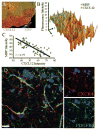CXCR4 signaling regulates remyelination by endogenous oligodendrocyte progenitor cells in a viral model of demyelination
- PMID: 21830237
- PMCID: PMC5025299
- DOI: 10.1002/glia.21225
CXCR4 signaling regulates remyelination by endogenous oligodendrocyte progenitor cells in a viral model of demyelination
Abstract
Following intracranial infection with the neurotropic JHM strain of mouse hepatitis virus (JHMV), susceptible mice will develop widespread myelin destruction that results in pathological and clinical outcomes similar to those seen in humans with the demyelinating disease Multiple Sclerosis (MS). Partial remyelination and clinical recovery occurs during the chronic phase following control of viral replication yet the signaling mechanisms regulating these events remain enigmatic. Here we report the kinetics of proliferation and maturation of oligodendrocyte progenitor cells (OPCs) within the spinal cord following JHMV-induced demyelination and that CXCR4 signaling contributes to the maturation state of OPCs. Following treatment with AMD3100, a specific inhibitor of CXCR4, mice recovering from widespread demyelination exhibit a significant (P < 0.01) increase in the number of OPCs and fewer (P < 0.05) mature oligodendrocytes compared with HBSS-treated animals. These results suggest that CXCR4 signaling is required for OPCs to mature and contribute to remyelination in response to JHMV-induced demyelination. To assess if this effect is reversible and has potential therapeutic benefit, we pulsed mice with AMD3100 and then allowed them to recover. This treatment strategy resulted in increased numbers of mature oligodendrocytes, enhanced remyelination, and improved clinical outcome. These findings highlight the possibility to manipulate OPCs in order to increase the pool of remyelination-competent cells that can participate in recovery.
Copyright © 2011 Wiley‐Liss, Inc.
Figures






References
Publication types
MeSH terms
Substances
Grants and funding
LinkOut - more resources
Full Text Sources
Other Literature Sources
Medical

